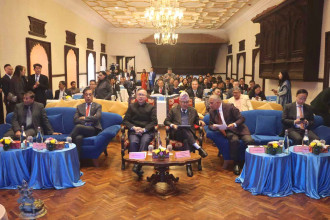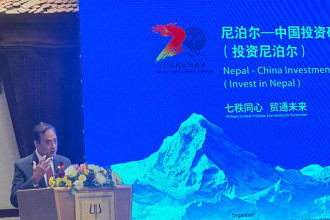-1733292759.jpeg)
KATHMANDU: A photo exhibition showcasing five decades of cooperation between Nepal and the Asian Development Bank (ADB) in the energy sector began at the Nepal Art Council, Babarmahal, on Tuesday.
-1733292759.jpeg)
-1733292758.jpeg)
State Minister for Energy, Water Resources and Irrigation, Purna Bahadur Tamang, inaugurated the exhibition, organised in collaboration with the Photojournalist (PJ) Club, Nepal.
-1733292758.jpeg)
During the inauguration, State Minister Tamang highlighted the significant role that donor agencies and development partners, including ADB, have played in the development of Nepal's electricity generation, transmission, and distribution systems. He mentioned that more than 95% areas of Nepal have been covered by electricity and expressed confidence that the country could achieve 100% electrification in a short period. He also mentioned Nepal's potential for surplus energy export.
“Given Nepal's substantial electricity production, we need to export it and increase domestic consumption. Taxis operating in major cities such as Kathmandu, Pokhara, Biratnagar, Chitwan, and others can be electrified,” said State Minister Tamang.
Secretary of the Ministry of Energy, Water Resources and Irrigation (MoEWRI), Suresh Acharya, stated that ADB is looking to invest in large projects, including Dudhkoshi and Upper Arun, with Nepal facilitating these investments.
-1733292758.jpeg)
ADB Country Director for Nepal, Arnaud Cauchois, said that ADB has invested in various hydropower projects, accounting for about 50% of the projects on the transmission line side and more than one-third in the construction of 33kV distribution substations. He mentioned that ADB has also invested in underground electricity distribution systems, vehicle charging stations, various generation and transmission projects, and private sector-promoted projects in Nepal. Cauchois highlighted that expanding access to electricity has played a role in raising living standards by creating employment in remote areas and generating various opportunities. He added that ADB will continue to support investment diversification, including private sector investment, through further strengthening, promotion, and development of sustainable business models in Nepal's energy sector.
Nepal Electricity Authority (NEA) Executive Director Kul Man Ghising remarked that ADB has been crucial in providing concessional loans, grants, and technical assistance to Nepal's energy sector. He mentioned that ADB has investments in power generation, transmission, distribution systems, smart meter installation, digital billing systems, and substation modernisation, among others.
The partnership between ADB and the Government of Nepal began in 1972 with investment in a transmission line project. With ADB's support, Nepal's first private sector investment, 60 Megawatts (MW) Khimti Hydropower Project, and the 144MW Kaligandaki-A project, the first project larger than 100MW, were built. The 140MW Tanahun Hydropower Project is also being developed with financial and technical support from ADB. Additionally, ADB has invested in transmission lines, including 400kV New Khimti-Kathmandu Project, Tamakoshi-Kathmandu transmission line, and the Mahendranagar-Kohalpur and Butwal-Kohalpur roads.
President of PJ Club, Nepal, Dwarika Kafle, stated that the exhibition aims to showcase the cooperation that has taken place in Nepal's infrastructure sector. The photo exhibition will run until December 9.






